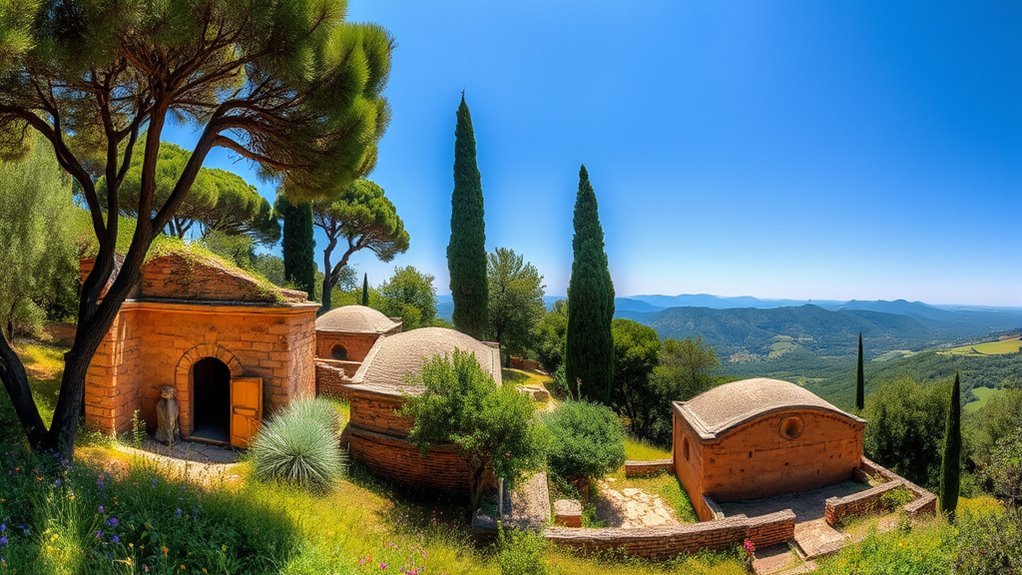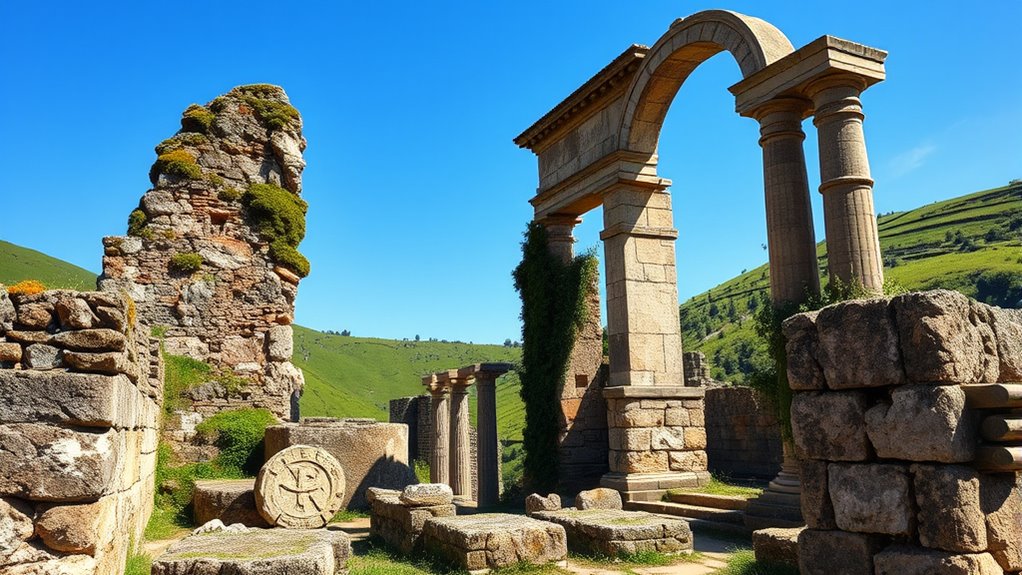Exploring Etruscan ruins in Central Italy offers you a fascinating glimpse into an influential ancient civilization. You can walk through well-preserved necropolises like Cerveteri and Tarquinia, marvel at vivid frescoes in tombs, and uncover inscriptions that reveal their unique language and culture. These archaeological sites showcase impressive architecture and craftsmanship, helping you understand their social and spiritual life. Continue your journey to discover even more about their enduring mysteries and remarkable history.
Key Takeaways
- Visit well-preserved sites like Cerveteri and Tarquinia to explore ancient necropolises and their intricate tomb art.
- Discover frescoes depicting banquets, rituals, and mythological scenes that reveal Etruscan cultural practices.
- Examine inscribed artifacts to learn about their language, family structures, and religious beliefs.
- Experience the sophisticated architecture and construction techniques of Etruscan city-states.
- Stay updated on recent archaeological discoveries that continue to uncover new insights into Etruscan civilization.

If you’re fascinated by ancient civilizations, exploring Etruscan ruins offers a compelling glimpse into a mysterious and influential culture. The Etruscans thrived in Central Italy long before the rise of Rome, leaving behind a wealth of archaeological treasures that reveal their unique way of life. As you wander through these ancient sites, you’ll notice the intricate remains of Etruscan tombs, which serve as both burial sites and artistic masterpieces. These tombs are more than just resting places; they are windows into their beliefs, customs, and social hierarchy. Many are decorated with vivid frescoes depicting banquets, funerary rituals, and mythological scenes, giving you vivid insights into their worldview. Exploring these ancient tombs, you can imagine how the Etruscans honored their dead and believed in an afterlife, which was central to their culture.
Discover Etruscan tombs decorated with vivid frescoes revealing their beliefs, customs, and social hierarchy.
One of the most fascinating aspects of Etruscan sites is the language inscribed on tomb walls and artifacts. Although the Etruscan language remains only partially deciphered, it continues to intrigue scholars and visitors alike. You might come across inscriptions that detail family names, titles, or religious practices, offering clues about their society. The language’s unique script, a mix of Greek and native elements, hints at cultural exchanges with neighboring civilizations. Despite the language’s mystery, the art and architecture of their tombs communicate a rich cultural identity that’s still compelling today.
As you explore, you’ll notice how well-preserved many ruins are, allowing you to envision how these ancient communities once thrived. From the strategic locations of city-states to the sophisticated construction of tombs, the Etruscans left a lasting legacy. The necropolises, such as Cerveteri and Tarquinia, stand as proof of their craftsmanship and spiritual beliefs. Walking among these ancient structures, you’re not just observing history—you’re stepping into a world that continues to puzzle and inspire. You can almost hear echoes of their rituals and feel the weight of their history in the silent stones.
In addition, recent archaeological discoveries and ongoing research continue to shed light on their ancient practices, offering new perspectives and insights into this enigmatic civilization. Walking through these sites, you’re engaging with a culture that’s still partly shrouded in mystery, but whose influence resonates through Italy’s history. You leave with a deeper understanding of the Etruscans’ complex society and their enduring mysteries, especially the enigmatic Etruscan language and the ancient tombs that continue to tell stories from the past.
Frequently Asked Questions
Are Etruscan Ruins Accessible Year-Round?
Etruscan ruins are generally accessible year-round, but accessibility can vary due to preservation challenges and seasonal weather. You should check local sites for specific opening times, especially in winter or during maintenance. Etruscan archaeology faces preservation challenges that sometimes limit access or restrict certain areas to protect delicate structures. Planning ahead guarantees you can enjoy the ruins comfortably while respecting their historical significance and ongoing preservation efforts.
What Are the Best Guided Tours Available?
You’ll find some fantastic guided tours highlighting Etruscan art and archaeological excavations. Look for reputable operators offering expert-led visits, which often include detailed insights into the history and significance of the ruins. Many tours take you through key sites like Tarquinia and Cerveteri, showcasing well-preserved tombs and artifacts. Booking in advance guarantees you won’t miss out on these immersive experiences, giving you a deeper understanding of Etruscan civilization.
Is Photography Allowed Inside the Ruins?
You wonder if photography is permitted inside the ruins. Typically, photography restrictions apply to protect the site’s integrity; flash photography and tripods are usually prohibited. You may be able to take photos with your camera or smartphone, but some locations require camera permits. Always check specific site rules beforehand, and respect signage to ensure you enjoy your visit while preserving these ancient wonders for future generations.
Are There Nearby Accommodations for Overnight Stays?
You’ll find plenty of local bed options and nearby hotels to suit your needs. After a day of exploring the ruins, you can relax comfortably at charming inns or modern hotels just a short drive away. Many accommodations offer scenic views and convenient access to the archaeological sites, making it easy for you to enjoy an overnight stay. Book in advance to secure the best rates and guarantee a seamless experience.
What Safety Precautions Should Visitors Take?
Imagine treading carefully through a fragile, ancient tapestry—your safety depends on it. You must follow visitor safety tips, stay on designated paths, and avoid touching delicate structures. Respect preservation guidelines to help protect these ruins for future generations. Keep an eye on your belongings, stay hydrated, and be mindful of uneven surfaces. Your cautious approach ensures a safe and respectful experience, safeguarding both yourself and these priceless archaeological treasures.
Conclusion
As you walk among the ancient Etruscan ruins, remember that every stone tells a story waiting to be uncovered. Like a treasure chest hidden beneath the earth, these ruins hold secrets of a lost civilization. Keep exploring with curiosity and patience, for as the saying goes, “A journey of a thousand miles begins with a single step.” Embrace each discovery, and you’ll find that history’s whispers become your own adventure.









